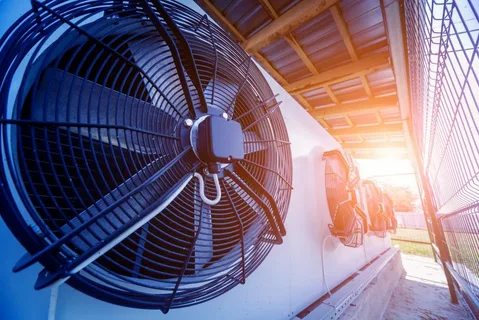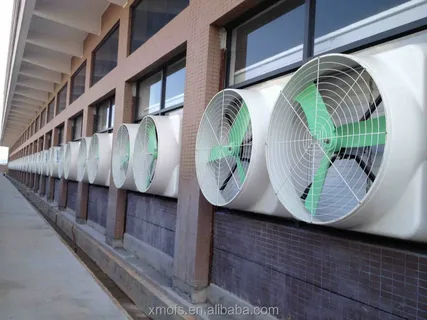We often take for granted the comfort and cleanliness of our indoor environment, not realizing the pivotal role played by a seemingly ordinary gadget like a ventilation fan. This blog post aims to unravel the purpose and importance of a ventilation-fan, highlighting its functionality, benefits and impact on indoor air quality.
How Does a Ventilation-Fan Work? Understanding the Basics
Ventilation-fans, often tucked away in our ceilings or walls, operate on a relatively simple principle. At its core, a ventilation-fan is an electrical device comprising of a motor-driven blade or impeller. When switched on, the motor turns the blade, causing air movement. This process creates a vacuum, pulling in fresh air from the outside or other areas whilst expelling the stale or polluted air out. The direction of airflow depends on the fan’s installation. Generally, ventilation-fans come in two varieties – extractor fans and supply fans.
An extractor fan pulls air from indoors and expels it outdoors, reducing levels of moisture, odor or pollutants. Supply fans, on the other hand, pull fresh air from the outside and introduce it indoors. Both varieties work in harmony to ensure air circulation in the building. More sophisticated systems such as heat recovery ventilation (HRV) or passive ventilation with heat-recovery (PVHR) include a heat exchanger element. As air is expelled, the heat from it is recovered and used to warm the incoming fresh air, promoting energy efficiency.
Importance of Proper Ventilation in Our Homes and Workplaces
Establishing adequate ventilation in our domestic and professional environments is essential for multiple reasons. The provision of fresh air, the removal of polluted air, and the control of temperature and humidity levels are just some of the responsibilities of a robust ventilation system. One of the primary roles of ventilation is to expel pollutants from the indoor environment. These pollutants can include dust particles, allergens, and smoke, as well as chemical fumes from household cleaning products or industrial processes.
Accumulation of these contaminants can lead to a host of health problems such as respiratory conditions, allergies, and even serious chronic illnesses in the long run. Beyond health considerations, ventilation also plays a key role in maintaining the overall comfort of indoor spaces. For instance, removing excess moisture helps prevent the growth of mound and mildew, which can damage structures, cause unpleasant odors, and exacerbate health problems.
Ensuring a steady supply of fresh air can help regulate temperature and humidity levels, creating a more comfortable and pleasant environment. In workplaces, the quality of ventilation has a direct correlation with productivity levels. Research has shown that employees are more efficient and focused in well-ventilated spaces. Poor ventilation, on the other hand, can lead to a lack of concentration, fatigue, and even reduced cognitive function.
Heat Exchange Ventilation Fan and Humidity Control
Heat exchange ventilation fan, commonly found in modern buildings, play a vital role in managing indoor humidity levels. These systems utilize a heat exchanger, which aids in the regulation of moisture and temperature levels in tandem. Humidity, or the amount of water vapor present in the air, can directly influence comfort levels, health, and even the structural integrity of a building. High humidity can lead to excessive moisture, fostering the growth of mound and mildew, damaging fixtures and furnishings, and leading to potential health issues.
On the flip side, low humidity can cause dryness, leading to irritated skin, respiratory discomfort, and an increased risk of wooden fixtures cracking. Heat exchange ventilation-fans are designed to tackle these issues effectively. As the warm, stale air is expelled, the heat exchanger within the ventilation system recovers the heat energy from this outgoing air. Simultaneously, it pre-warms the incoming fresh air, reducing the temperature difference between the inside and outside environments.
But how does this affect humidity control? When the incoming cold air is pre-heated, its relative humidity decreases. The result is the fresh air entering the indoor environment has a lower moisture content, which in turn helps to control indoor humidity levels. By fine-tuning the heat recovery process, a balance can be achieved between the need for fresh air and the requirement to maintain an optimum humidity level.
Air Quality and Ventilation-Fans
A pivotal function of ventilation-fans is the regulation of indoor air quality, a critical element of maintaining a healthy and comfortable environment. But how exactly do ventilation-fans contribute to this? Ventilation-fans aid in diluting airborne pollutants. Indoor environments often harbor a variety of contaminants such as dust particles, volatile organic compounds (VOCs), smoke from cooking, and chemical fumes from cleaning products. A ventilation-fan effectively removes these pollutants by creating a continuous flow of air, reducing their concentration and thus lowering the potential health risks associated with poor air quality.
Ventilation-fans are crucial in supplying fresh air. By bringing in fresh air from the outside, a ventilation-fan mitigates the build-up of carbon dioxide (CO2), a common byproduct of human respiration. High levels of CO2 can lead to drowsiness, headaches, and shortness of breath and, over the long term, can negatively affect cognitive function.
The constant supply of fresh air, courtesy of the ventilation-fan, aids in maintaining optimum CO2 levels, thus promoting alertness and overall well-being. Ventilation-fans also help control the spread of airborne diseases, particularly in crowded or poorly ventilated spaces. By reducing the concentration of airborne pathogens, the chances of disease transmission can be considerably lowered. This becomes particularly important in shared living spaces, offices, or any indoor environment with high foot traffic.
The Lesser-Known Benefits of Heat Exchanger Fan
Ventilating with heat exchanger fan presents an array of benefits beyond the principal functions of temperature and humidity control. One such advantage is the capacity for noise reduction. By maintaining a consistent airflow within an indoor environment, heat-exchanger fans work to effectively dampen external sounds. This can prove especially beneficial in bustling urban settings, where incessant outdoor noises can often disrupt indoor tranquility. Hence, the use of heat-exchanger fans can significantly contribute to achieving a quieter and more serene living or working space.
Apart from this, another critical advantage is the enhancement of energy efficiency. As discussed earlier, the heat-exchanger fan mechanism involves capturing the heat from the outgoing air and using it to warm up the incoming fresh air. This heat recovery process minimizes the requirement for additional heating resources during colder seasons, thereby promoting substantial energy savings. This not only reduces the overall energy costs but also contributes towards a more sustainable and eco-friendly living or working environment. Thus, the use of heat-exchanger fans goes beyond the traditional notions of ventilation, offering numerous lesser-known benefits that further enhance the overall indoor atmosphere.
Heat Recovery Fan and Energy Efficiency
Delving deeper into the relationship between heat recovery fan and energy efficiency, we uncover another layer of benefits these fans provide. Primarily, the energy efficiency of these devices stems from their ability to recycle heat from expelled indoor air, reusing it to warm the incoming fresh air. This process effectively reduces the dependence on external heating sources, particularly during colder seasons, thus leading to considerable energy savings.
With the rising energy costs and increasing emphasis on sustainable practices, this aspect of heat recovery-fans is particularly noteworthy. By reutilizing the otherwise wasted heat energy, these fans embody the principle of ‘energy conservation’, a cornerstone of sustainable living. For homeowners and business operators alike, this translates into substantial cost savings on energy bills over time. Importantly, these benefits do not come at the expense of the fan’s primary function – ventilation.
These fans continue to ensure the steady circulation of air, maintaining optimum indoor air quality whilst offering the added advantage of energy efficiency. Heat recovery-fans also adapt to changes in the indoor and outdoor environment. For instance, during warmer months, the heat from the expelled indoor air can be transferred to the cooler, incoming air, reducing the need for additional cooling mechanisms. This versatility furthers their contribution to energy efficiency, making them an ideal choice for varying climatic conditions.
 The Indispensable Passive Ventilation with Heat Recovery
The Indispensable Passive Ventilation with Heat Recovery
Passive Ventilation with Heat Recovery, more commonly known as PVHR, represents an innovative approach that marries the advantages of passive ventilation and heat recovery ventilation into one cohesive system. The crux of the PVHR system is its reliance on natural air movement for ventilation, sidestepping the need for motor-driven fans. It utilizes the principle of buoyancy – the natural tendency of warm air to rise and cold air to sink – to create a continual flow of air through your space.
Fresh air is drawn in from the outside, while stale or polluted air is simultaneously expelled, creating a continuous cycle of air renewal. What sets PVHR apart is the incorporation of a heat exchanger. In simple terms, a heat exchanger is a device that transfers heat from one medium to another. In the context of a PVHR system, as the warm, outgoing air passes through the heat exchanger, its heat is extracted and used to warm the cool, incoming air. This minimizes heat loss and the need for additional heating, making PVHR an energy-efficient solution.
PVHR systems also play a crucial role in controlling humidity. The heat exchange process helps to maintain optimal moisture levels, preventing issues caused by both high and low humidity. PVHR systems also serve an essential function in air purification. They can reduce concentrations of indoor pollutants and ensure a steady supply of fresh air. This contributes to better indoor air quality, leading to improved health and well-being.
FAQs
What is a ventilation fan?
A ventilation fan is an electrical device, often placed in ceilings or walls, which promotes air circulation in a space by pulling in fresh air and expelling stale or polluted air.
What is the difference between an extractor fan and a supply fan?
Extractor fans work by pulling air from indoors and expelling it outdoors, reducing levels of moisture, odor or pollutants. Supply fans, on the other hand, draw in fresh air from the outside and introduce it indoors.
What are the health benefits of a ventilation-fan?
Ventilation-fans can reduce the concentration of indoor pollutants such as dust, allergens and chemical fumes. They can also control the spread of airborne diseases and maintain optimum CO2 levels, thereby contributing to overall well-being.
Can a ventilation-fan help with humidity control?
Yes, some ventilation-fans, specifically those with heat exchangers, can effectively control indoor humidity levels by adjusting the moisture content of the incoming fresh air.
What is a heat recovery ventilation-fan and how does it promote energy efficiency?
Heat recovery ventilation-fans are designed to recycle the heat from the expelled indoor air, using it to warm the incoming fresh air. This process minimizes the need for additional heating resources, thus promoting substantial energy savings.
Conclusion
The importance of a ventilation-fan extends beyond simple air circulation. Its role in maintaining air quality, controlling humidity, enhancing comfort, and even boosting energy efficiency underlines its essentiality in both domestic and professional environments. A robust understanding of its functionality can help optimize its benefits, contributing to a healthier and more sustainable living environment. Whilst it might be an often-overlooked device, the ventilation-fan indeed holds a pivotal place in creating pleasant and productive indoor spaces.
| Other Good Articles to Read |
| Niche Blogs Connect |
| Blogs 97 |
| Blog Stitution |
| Blogs Cotch Rouge |
| Blog Signatr |
| Blog Sintonias |
| Blog Zilla |
| Consumer Forums |
| Finance Forums |
| G Blogs |
| Too Blog |
| Related Business Listings |
| Contact Directory |
| Local Business Profiles |



